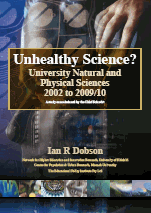
Unhealthy Science?
Ian Dobson Delivers the First of Three Studies Commissioned by Australia's
Chief Scientist

|
Editorial
- 31 January 2012 |
|
|
Unhealthy Science? Ian Dobson Delivers the First of Three Studies Commissioned by Australia's Chief Scientist |
|
The 88-page report
Unhealthy Science?: University
Natural and Physical Sciences 2002 to 2009/10![]() is to form part of the
broader study of the health of Australian science, promised to be released in
March this year.
is to form part of the
broader study of the health of Australian science, promised to be released in
March this year.
_______________________________________________
In 1999, the Australian Council of Deans of Science (ACDS) published a report commissioned from Dobson and Calderon, Trends in Science Education to determine the participation in university science courses from 1989 -1997. According to the ACDS: "Dobson and Calderon concluded that, 'short term excesses in supply (of graduates) may not reflect the long term outlook' (p76). The report also demonstrated, in a stark fashion, the decline of enrolments in the 'enabling sciences' of Mathematics, Physics and Chemistry over the past ten years."
Subsequently two additional analyses were undertaken: Science at the Crossroads? A study of trends in university science from Dawkins to now, 1989 – 2002 (Dobson, 2003) and Sustaining Science: University Science in the Twenty-first Century (Dobson, 2007).
In that second of the studies Dr. Dobson wrote:
The major concern, however, ought to be with the longer term and with the patterns discernable over the past 15 – 20 years. As shown in Table 78 when examining the pattern back to 1989, the long-term absolute decline in chemistry, physics and mathematics ought to ring alarm bells. The ‘steady as she goes’ pattern of 2002-5 hides the fact that the 1990s saw sharp declines in enabling sciences participation by students enrolled in courses in the Natural and Physical Sciences. The number of enrolments has roughly doubled since 1989, with some uncertainty due to the changes in counting methodology, yet during such spectacular growth in the system the number of equivalent full-time science students taking chemistry declined by 315 or 5.3 per cent. For physics the decline was 701 about 19 per cent. In 1989 there were 7,520 equivalent full-time science students enrolled in mathematics; in 2005 this number had dropped to 4,988. This is a decline of 2,532 equivalent full-time students, or about one-third.
It is not only against this background that Dr Dobson's conclusions in Unhealthy Science? should be judged. Ask what has the rest of our cohort of nation's been doing while Australia has effectively been treading water this decade and is that good enough?
Is [Australian] science going well? From the vast quantities of data available in Australian higher education, it is possible to conclude that the Natural and Physical Sciences held their ground in the 2000s. However, caution is required in considering the health of science teaching and learning at Australian universities... it is not possible to provide an exact comparison of the situation in 2000 and before with that pertaining to 2002 and later. However, earlier studies undertaken for the ACDS pointed to considerable declines in the 1990s in the enabling sciences built around chemistry, mathematics and physics (ACDS, 1999).
The Natural and Physical
Sciences held their ground during the first decade of the twenty-first century,
so on one level, perhaps there is little to be concerned about. However, one
should ask if this is good enough for a technologically-advanced society.
Typically one expects innovation to come out of science and technology, rather
than from say, management, commerce, and health, areas that have been the most
dynamic in enrolment expansion this century.
But Dr Dobson makes the point (p.5): "For these reasons [variations in methods of classification between years and between universities], it is necessary to be wary when comparing patterns at different universities, or when Australia’s performance is being compared internationally. Sometimes one should take statements about Australia’s university performance compared with other nations with a grain of salt, pending knowledge of what is being compared, and what information was supplied."
So, are we really in a situation where we're unable to make dynamic judgments regarding our tertiary STEM education in comparison to say the top third of the OECD?
Without a serious attempt to make those determinations the Chief Scientist and his office are not fulfilling one of the paramount reasons for continued taxpayer support.
Alex Reisner
The Funneled Web